explore
Andean Highlands - Resources
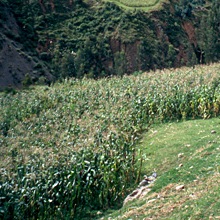
Different crops are (and were) grown in different environmental zones on the cordillera, with shorter plant growth cycles at higher elevations. At 2,500 - 3,200 metres above sea level there are fertile valleys running north and south. These valleys lie within the quechua ecological zone. During Inka times, the slopes were terraced and the maize produced was used as a staple food and made into chicha or maize beer, important in Inka ritual and feasts.
Image: A patch of maize grows near the edge of a cliff near the village of Chahuaytiri in the department of Cusco. Maize, an important staple, grows well here because it is below 3200 metres in elevation.
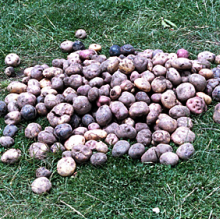
Between 3200 to 4000 metres above sea level are the suni (the mountain slopes leading up from the valleys). Here people grew potatoes and other tubers such as olluco, oca and mashwa, as well as the Andean grain quinoa.
Higher still at 4,000 to 5,000 metres, lay the puna which is pasture land for the wild camelids (guanacos and vicuñas) and the domesticated llamas and alpacas.
Image: A selection of some of the 3800 different varieties of potato that have been cultivated in the Peruvian highlands since ancient times.
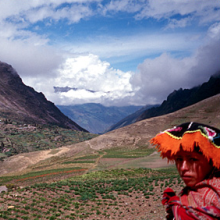
The following sections describe several strategies that ancient and modern highland peoples have developed to make the most of their varied and harsh environment.
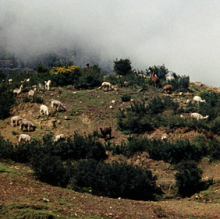
Verticality
As already explained, the Andean terrain varies a great deal. Communities have benefited if they exploit as many resource zones as possible in addition to the ones they live in. Communities may hold lands or grazing rights in other resource zones, sometimes many hours away from their primary homes. The main ecological zones exploited include high pasture, lower potato lands and the still lower maize lands. Ancient peoples obtained the products of these different zones by moving products up and down using llamas as pack animals.
Image: High above irrigated fields below them, young men herd grazing camelids.
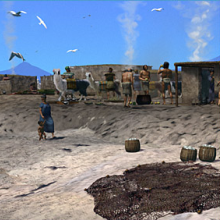
Wool for weaving (and sometimes the textiles themselves) came from the high Andean plateau, the home of the wool-producing llamas and alpacas. Wool was brought to the lower elevations to exchange for coastal items such as cotton cloth, dried fish, and other produce. Tropical bird feathers, coca leaves and other products were brought from the eastern slopes and rainforest. Links between highland and coastal peoples existed from early times and trade routes were followed for centuries based on this vertical system of bonds between individuals, families and larger units.
Image: Computer generated scene of coastal life near Chan Chan, the capital of the Chimú.
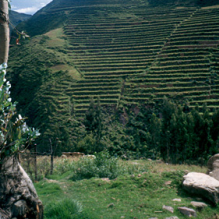
In the highlands, agricultural terracing helped people to farm as much land as possible, and helped the land to hold moisture. An enormous amount of labour went into building and maintaining agricultural terraces. Farmers also built and maintained canal systems to use streams for irrigation. On the shore of Lake Titicaca, there were raised field systems called waru waru which made the wetlands productive and helped prevent frost damage. To take advantage of the freezing nights and warm days of the highlands, farmers produced chuño (freeze-dried potatoes) and charki (freeze-dried meat). These processes made food easy to store and last longer.
Image: Inka terraces transformed steep slopes into productive farmland.
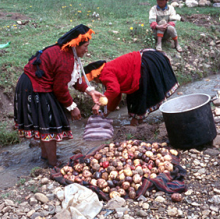
Most of the plants grown by ancient peoples in the Central Andes were indigenous to the area, and the most important were potatoes, maize and cotton. In the highest areas people grew potatoes, grains such as quinoa and canihua, and tubers such as oca, ulluco and anu. Lower valleys yielded maize, legumes such as tarwi, the fruits molle, lucuma and pacae, as well as squash, chili peppers, and the grain amaranth.
Image: Women from the highland village of Chahuaytiri, in the department of Cusco, wash potatoes in a small irrigation canal.
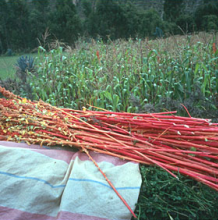
Many of these plants were originally domesticated in the Andes, and many were never grown elsewhere in the Americas. Maize and squash had their origin farther to the north in Mexico, but were introduced into Peru at an early date. Manioc and peanuts were first cultivated in the tropical lowlands of South America and spread to Peru. Tobacco, the sweet potato and lima beans were probably first cultivated in Peru. The potato was taken by the Spanish to Europe and was a significant contribution of the ancient peoples to the diet of our modern world.
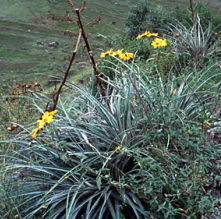
Many wild plants were also gathered as food, or grown or gathered for the manufacture of dyes and cordage or for medicinal purposes. Examples of medicinal plants include mishpingo, a seed pod used for medicine, and una del gato (cat's claw). Relbunium, a plant related to the European madder (Rubia tinctorum), is thought to have been used to produce red dyes, while indigo was cultivated to create blue dye.
Image: Today weavers in the Cusco area prepare natural dyes from local plants. Q'olle flowers are gathered and used to dye wool a variety of yellows.

The grain quinoa is an example of an Andean crop that was not cultivated in other parts of the ancient Americas. Maize on the other hand spread throughout the hemisphere in ancient times. First cultivated in Mexico, it became a staple crop in South America and as far north as Canada.